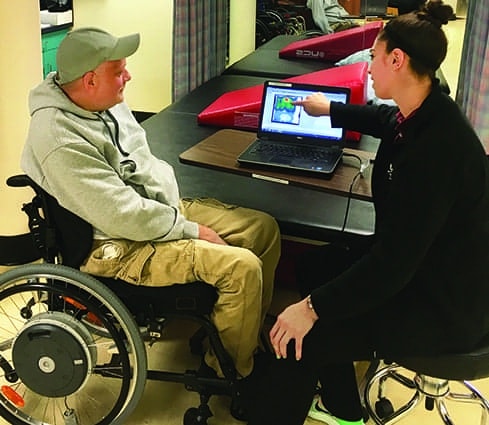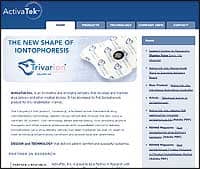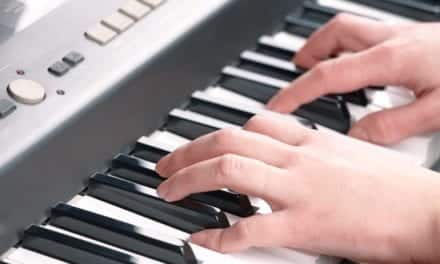
Pressure mapping can objectively compare cushions to determine overall pressure distribution, which is essential for those with impaired sensation and at significant risk of pressure injury.
by Alexandra Coya, MOTR/L The wheelchair and seating system evaluation and fitting process is a specialized and skilled therapeutic approach to maximize a person’s ability to function. Without an adequate mobility device or a proper seating system, a person’s quality of life, participation in all areas of occupation, self-esteem, self-efficacy, and social interaction are severely impacted. Therefore, it is essential to find the person-product match that best suits each individual. Various methods of evaluating a person’s mobility and seating needs are utilized by different therapists, assistive technology professionals (ATPs), and rehabilitation facilities. This article briefly outlines methods to evaluate a person and considerations to include in the evaluation process to determine the best person-product match.
Evaluation Process
At Kessler Institute for Rehabilitation, a thorough evaluation of a person’s seating and mobility needs is performed, which maximizes the client’s postural support, pressure distribution, and ensures the ability to use the wheelchair independently and safely for at least 5 years. This is generally how often insurance companies will fund a replacement wheelchair if the cost of repairs outweighs the cost for a new wheelchair. For this reason, each client has a chance to trial several products to ensure that they are satisfied with the wheelchair and seating system, and how it enables them to function. Once the initial evaluation is completed, a mat evaluation is performed to reveal the exact nature of deformities (ie, fixed, flexible, or difficult to correct) and lower extremity range of motion (ROM) limitations to determine postural support needs against gravity. With the information discovered from the mat evaluation, the client may trial several back/trunk support options. It is necessary to provide adequate postural support, alignment, and overall stability in the wheelchair seating system while maximizing the person’s ability to function and independently mobilize themselves. Each user’s postural support needs in relation to their functioning must be considered. For example, although a more supportive back with deep lateral contour minimizes the risk of increased deformity and increases overall stability, it can be restricting and impede functioning (ie, lateral transfers, picking something off the floor, reaching to the sides). Therefore, the mat evaluation reveals what kind of support a person can benefit from but essentially, it is frequently the client’s ability to function with a specific type of support that supersedes. A pressure mapping system is commonly utilized to objectively compare cushions to determine an appropriate choice based on a person’s skin integrity and support needs. Specifically, although an air cushion provides increased pressure distribution for those at high risk for pressure injuries, it provides very little to no pelvic support/stability. On the other hand, a positioning cushion will provide good support/stability but very little pressure distribution. Therefore, it is essential for the team to consider the person’s skin and support needs to determine the best person-product match: positioning (ie, foam), pressure distributing (ie, air), or positioning/pressure distributing combination (ie, foam/air, foam/fluid gel). The trial of several combinations of back supports and cushions are generally simultaneously combined with the trial of wheelchairs indoors and outdoors. Once the wheelchair and seating system is chosen, the wheelchair team completes an order form. This includes measurements of the wheelchair setup and additional wheelchair components.
Rigid or Folding?
When considering manual wheelchair options, it’s imperative to consider functional implications. For example, if a person performs a transfer with their feet on the ground, the wheelchair team should consider a flip-up footplate on a rigid wheelchair or a folding wheelchair as the footplates swing out of the way. In addition, it is crucial to consider how the person will transport this mobility device. If the person has a standard car and loads/unloads the wheelchair by bringing the frame over the steering wheel, a rigid wheelchair is the better option. If the client has a car topper or has a family member load the wheelchair into the trunk of a car, a folding wheelchair must be considered. Other functional considerations include how the person will mobilize themselves, their activity level, and the need for more efficient mobility.
Power Assist
Due to upper extremity overuse associated with being a manual wheelchair user, a person is at significant risk of upper extremity pain, strain, and injury. A manual wheelchair with a power assist device can aid in mobility-related activities of daily living. A power assist device added to the wheelchair’s axle decreases the stress on upper extremities by reducing propulsion stroke frequency. This is most beneficial for long distances and inclines. Additionally, the design of this type of system adds less weight to the wheelchair frame and is easily removed. Power assist wheels magnify the effort that a person uses to propel their wheelchair by minimizing the force required by the user. This results in increased independence and efficiency propelling the wheelchair throughout the day. In addition, some power assist wheels can be programmed to change the sensitivity of each wheel, which assists with more efficient propulsion if one upper extremity is stronger than the other.
Power Wheelchairs
When evaluating power wheelchair needs, the power base and drive method is essential to consider, trial, and compare. The power base options include a front, mid, and rear wheel drive. The front wheel base transitions over uneven surfaces more smoothly and has the tightest front turning radius. However, this base has the largest overall turning radius as the turning, or “swing,” happens behind the person. The mid wheel base is the most maneuverable of the power wheelchairs to fit in the tight spaces of a person’s home. The rear wheel base provides the user with the most visual field as the turning, or “swing,” happens in front of the person. The client should be provided the opportunity to trial each base to compare and determine which would best meet their lifestyle, home, and community needs.
Alternative Drive Options
Several power wheelchair users cannot safely and independently use a standard joystick due to active range of motion (AROM), strength, coordination, and endurance limitations. Therefore, alternative drive options including a mini joystick, foot control, switch drive, head array, and sip and puff are considered. The alternative drive option chosen is directly related to the client’s clinical presentation. For example, if a person has no AROM of their upper extremities or head/neck, a sip and puff drive control could be considered. In addition, the wheelchair team must consider if a person’s symptoms are progressive and the rate of the progression. Any drive control should be trialed in various environments to determine any barriers.
Power Seat Functions
Power seat functions are an essential feature of power wheelchairs to assist the client with support against gravity, to perform a weight shift, and function as independently as possible. Power seat function options include power tilt, recline, seat elevate, and elevating leg rests. The combination of power tilt and recline is essential to achieve an adequate pressure relief technique, as wheelchair users do not get sufficient relief of their buttocks with power tilt or recline alone. These functions are necessary to minimize a person’s risk for pressure injuries. In addition, the power tilt alone tips the wheelchair seating system back without changing the back angle to provide the client with increased stability via gravity to compensate for impaired balance and assist with upright sitting. The recline alone is used when the client has hip ROM limitations, descends ramps and inclines for adequate trunk stability, and to position a person’s paralyzed trunk forward to enable them to function and feed themselves at a table. The seat elevate power function enables the client to maneuver the wheelchair into a higher position. This can enable lateral transfers to a lower surface more safely and independently. For those with significantly impaired upper extremity AROM and strength, the seat elevate in the highest position assists the person to utilize available arm range to access higher items (ie, closets, refrigerator, cabinet shelves). For those with very limited active head and neck ROM, the seat elevate is necessary for safety as it provides the ability to elevate the seat when negotiating in cluttered areas to see around obstacles in the environment. Lastly, the elevating leg rest function assists a person with managing lower extremity positioning and edema. However, this is not an appropriate seat function for all wheelchair users. For example, if the person has knee extension limitations when their hips are flexed, they do not have the hamstring flexibility or knee range to utilize this seat function safely.
In Conclusion
Ultimately, the goal of the wheelchair and seating system is to provide a person with the maximum capacity to function as independently as possible. Therefore, the team must evaluate a person’s clinical and functional status, determine each individual’s needs, and trial several options to determine the best person-product match. RM Alexandra Coya, MOTR/L, earned a master of occupational therapy and a bachelor of health science from Quinnipiac University. She has been an occupational therapist for 3 years and has specialized in wheelchair seating and mobility at Kessler Institute for Rehabilitation, West Orange, NJ, for 2 years. She works in the outpatient wheelchair services at Kessler. For more information, contact [email protected].
Funding Standing Systems: Team Process
By Frank Long, Editorial Director Uniting a force of multiple disciplines can help meet the challenges of securing funding for a standing system. This team process considers four stakeholder groups, with each group contributing certain functions directed at funding the device:
Consumer
• Team leader, who must follow funding through its conclusion; • Selects a complex rehab technology supplier willing to work with the user and payor(s); • Has awareness of the medical need to stand; • Researches the benefits of standing; • Specifies wants and needs for the standing device; • Trials and determines the standing device; • Is present for the final adjustment; and • Begins an appeal, if necessary.
Caregiver/Family Members
• This individual(s) assumes the role of the consumer if the consumer is a minor or unable to fulfill the role personally; and • Provides feedback to team about transfers/ADLs, etc.
Rehab Technology Supplier
• Provides a trial standing device or schedules a product trial with a local manufacturer’s representative; • Provides expertise about the standing device and options; • Acquires prior authorization with the funding source; • Assembles, delivers, and adjusts the device for proper fit; and • Assists with the appeals process as necessary.
Clinician
• Determines medical clearance for the consumer to stand; • Recommends weight bearing/standing device and program; • Reviews standing device options and makes recommendations; • Writes letter of medical necessity (LMN), including trial process; • Physician usually co-signs the therapist’s LMN or writes an additional prescription; • Attends and assists in the standing device final adjustment; • If the standing device is denied, the clinician writes an addendum or new LMN, and/or attends appeals hearing; and • Monitors the client’s ongoing standing program.





Hello, my name is Edward Fuller, I can’t walk and I’m trying to get the best heavy-duty power wheelchair for me I’m 6’4 and weigh 450lbs please help me I’m trying my best I do have a power wheelchair with me now but, I can’t fit in it that’s the only way I can move around please
Hello Edward: We cannot offer medical advice or advice about equipment purchases. You may want to contact your primary care provider about how to resolve this issue. A local mobility dealer may also be able to help you put together a strategy.
—Ed.